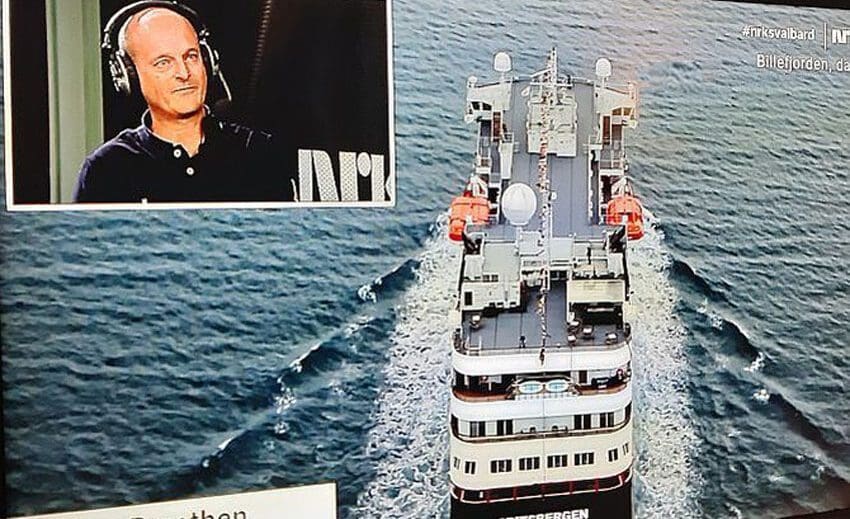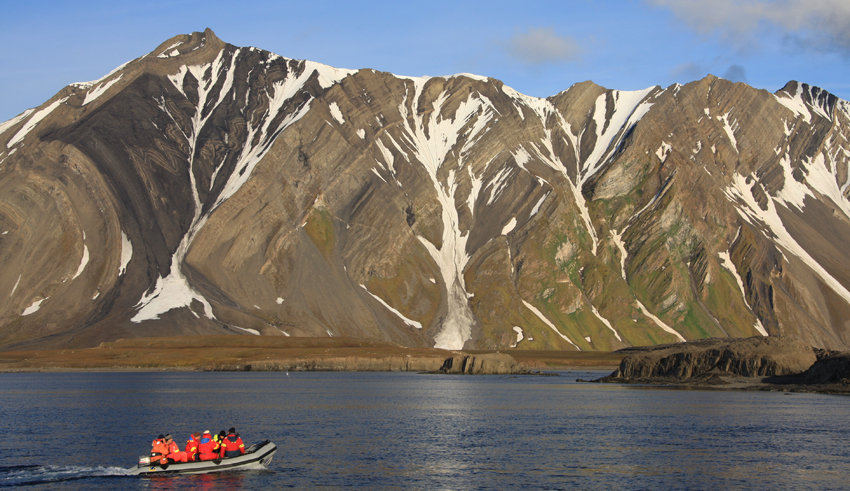Svalbard’s geology live

Top image: Alvar Braathen commented directly from the studio during the broadcast of “Svalbard minute by minute” on 9 February. Photo: NRK TV (facsimile) Gunn Kristin Tjoflot/UiO.
During 9 days in late January-early February, NRK has shown Hurtigruta on a slow-TV cruise; “Svalbard minute by minute”. The actual journey was recorded in August 2019, but now NRK has added expert commentary lives from the studio. One of the experts is Professor Alvar Braathen, Department of Geosciences at UiO and adjunct professor at UNIS, who has first-hand knowledge of Svalbard’s geology.
18 February 2020
Text: Gunn Kristin Tjoflot/University of Oslo (UiO)
The last day of “Svalbard minute by minute” on the Norwegian national broadcaster NRK slow TV series was Sunday 9 February. The TV viewers had then for more than 9 days followed the cruise ship MS Spitsbergen sailing around Svalbard.
UiO professor in geology Alvar Braathen participated in the last broadcast as an expert commentator. He commented directly during the show from the NRK studio in Bergen. Braathen commented on the geological conditions of the archipelago and especially about how this land far north was created, the characteristic mountains, the varied landscape, and about ice ages and climate. He answered and answered questions from the viewers, something that was very popular.
We also asked some questions to the busy professor, who is also adjunct professor at the University Centre in Svalbard (UNIS).
How do you know Svalbard?
– I have a long history with Svalbard. The first time I visited the islands was in 1992, when I started my PhD studies. Then I got hooked. Since then, I have visited Svalbard every year, especially in the summer when geology is at its best. I also worked at UNIS for 7 years, then as a resident of Longyearbyen. Those years provided unique opportunities to see Svalbard’s geology.
What does Svalbard mean for your (and the institute’s) teaching and research?
– Svalbard exposes the seabed in the Barents Sea, which is unique in the Norwegian context. Norway’s mainland is made up of older bedrock, while Svalbard’s many layers are made up of sedimentary deposits. Svalbard is therefore a unique region for geologists, where we can see geology that otherwise only appears in cores from boreholes and sound wave imaging. Most people visiting Svalbard in the summer will see geologists in action in the mountains. UNIS students benefit from the fantastic exposures, but there are also many geologists from other universities and partly from Norwegian industry who come to learn, says Braathen.
Watch the broadcasts at your convenience
After seeing “Svalbard minute by minute” one can form a picture of the geological past of the archipelago all the way to the north. You see how beautiful and varied the landscape is, and not at least capture how vast it is, illustrated by the fact that it takes a whole 9 days to travel around Svalbard.
You can watch the entire broadcast on NRK TV with comments and fantastic pictures where the Hurtigruta sails into Billefjorden and Isfjorden en route to Longyearbyen.
NRK TV (player): Svalbard minute by minute (day 10, 20:00)
“Svalbard minute by minute” is NRK’s anniversary celebration of the Svalbard Treaty. The treaty was signed in Paris on February 9, 1920 by negotiator Fritz Wedel Jarlsberg, and gave Norway sovereignty over Svalbard. Read more on Svalbard minute by minute NRK.
What is slow TV?
Slow TV is a collective term for a genre of television program of an ordinary event in its full length. The programs can be both direct and recorded.
Source: Wikipedia.
This article was originally published in Norwegian on the UiO website.
